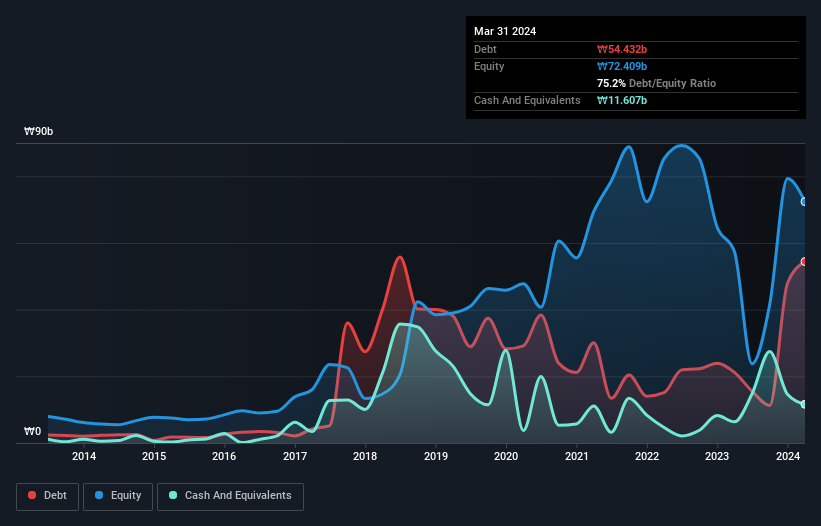
Howard Marks put it nicely when he said that, rather than worrying about share price volatility, 'The possibility of permanent loss is the risk I worry about... and every practical investor I know worries about.' When we think about how risky a company is, we always like to look at its use of debt, since debt overload can lead to ruin. As with many other companies ENPLUS Co., Ltd. (KRX:074610) makes use of debt. But is this debt a concern to shareholders?
What Risk Does Debt Bring?
Debt assists a business until the business has trouble paying it off, either with new capital or with free cash flow. In the worst case scenario, a company can go bankrupt if it cannot pay its creditors. While that is not too common, we often do see indebted companies permanently diluting shareholders because lenders force them to raise capital at a distressed price. Of course, the upside of debt is that it often represents cheap capital, especially when it replaces dilution in a company with the ability to reinvest at high rates of return. The first thing to do when considering how much debt a business uses is to look at its cash and debt together.
View our latest analysis for ENPLUS
What Is ENPLUS's Debt?
You can click the graphic below for the historical numbers, but it shows that as of March 2024 ENPLUS had ₩54.4b of debt, an increase on ₩21.2b, over one year. However, it also had ₩11.6b in cash, and so its net debt is ₩42.8b.

How Strong Is ENPLUS' Balance Sheet?
According to the last reported balance sheet, ENPLUS had liabilities of ₩89.8b due within 12 months, and liabilities of ₩8.70b due beyond 12 months. Offsetting this, it had ₩11.6b in cash and ₩10.5b in receivables that were due within 12 months. So its liabilities total ₩76.4b more than the combination of its cash and short-term receivables.
While this might seem like a lot, it is not so bad since ENPLUS has a market capitalization of ₩210.1b, and so it could probably strengthen its balance sheet by raising capital if it needed to. However, it is still worthwhile taking a close look at its ability to pay off debt. When analysing debt levels, the balance sheet is the obvious place to start. But you can't view debt in total isolation; since ENPLUS will need earnings to service that debt. So if you're keen to discover more about its earnings, it might be worth checking out this graph of its long term earnings trend.
In the last year ENPLUS wasn't profitable at an EBIT level, but managed to grow its revenue by 82%, to ₩53b. With any luck the company will be able to grow its way to profitability.
Caveat Emptor
Despite the top line growth, ENPLUS still had an earnings before interest and tax (EBIT) loss over the last year. Indeed, it lost a very considerable ₩24b at the EBIT level. When we look at that and recall the liabilities on its balance sheet, relative to cash, it seems unwise to us for the company to have any debt. So we think its balance sheet is a little strained, though not beyond repair. However, it doesn't help that it burned through ₩14b of cash over the last year. So suffice it to say we consider the stock very risky. There's no doubt that we learn most about debt from the balance sheet. But ultimately, every company can contain risks that exist outside of the balance sheet. To that end, you should learn about the 4 warning signs we've spotted with ENPLUS (including 2 which can't be ignored) .
Of course, if you're the type of investor who prefers buying stocks without the burden of debt, then don't hesitate to discover our exclusive list of net cash growth stocks, today.
Valuation is complex, but we're here to simplify it.
Discover if ENPLUS might be undervalued or overvalued with our detailed analysis, featuring fair value estimates, potential risks, dividends, insider trades, and its financial condition.
Access Free AnalysisHave feedback on this article? Concerned about the content? Get in touch with us directly. Alternatively, email editorial-team (at) simplywallst.com.
This article by Simply Wall St is general in nature. We provide commentary based on historical data and analyst forecasts only using an unbiased methodology and our articles are not intended to be financial advice. It does not constitute a recommendation to buy or sell any stock, and does not take account of your objectives, or your financial situation. We aim to bring you long-term focused analysis driven by fundamental data. Note that our analysis may not factor in the latest price-sensitive company announcements or qualitative material. Simply Wall St has no position in any stocks mentioned.
About KOSE:A074610
Slight and slightly overvalued.
Market Insights
Community Narratives





